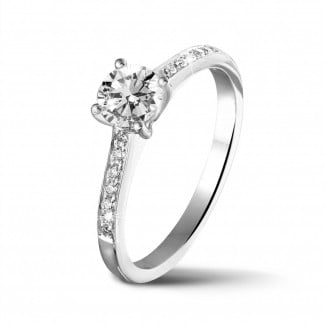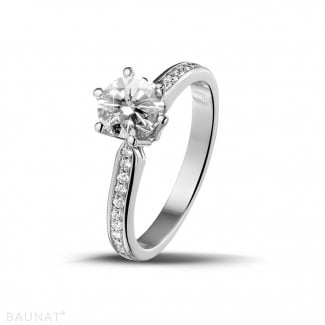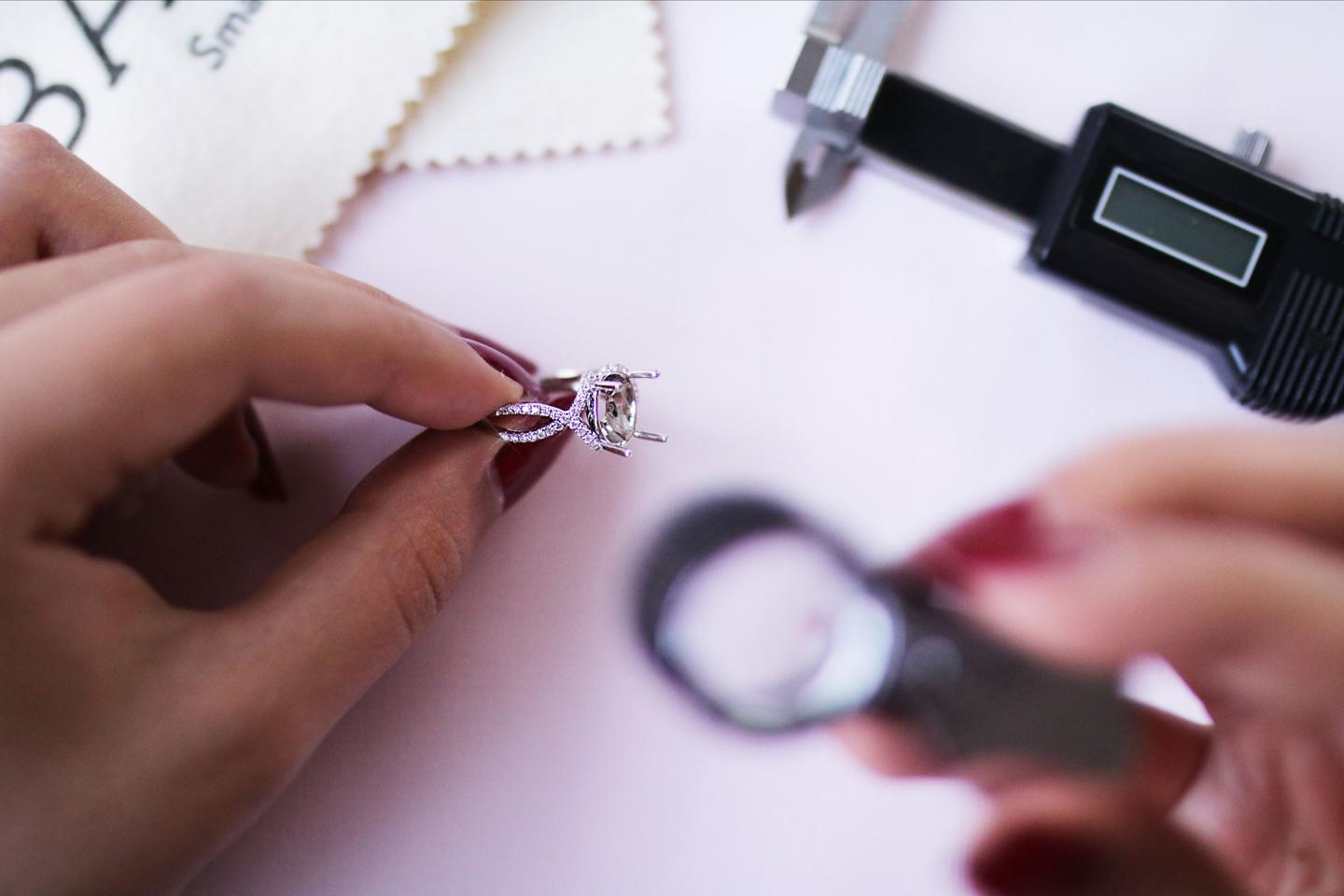Inspirational insights
Blogs in the spotlight
- How do I buy the perfect diamond ring?
- Choosing the perfect wedding ring
- Buying an engagement ring: expert tips & tricks
- Which earrings are the right ones for you?
- How to choose the perfect diamond bracelet?
- How to choose a necklace for ladies?
- Take your time in choosing your watch
- What's the right jewellery for each occasion?
- Why buy diamond jewellery online?
- A guide to building up your jewellery collection
- What types of precious metals are there?
- What types of precious metals are there?
- Jewellery trends and innovations in 2020
- What sorts of diamond setting are there?
A robot which cuts diamonds perfectly? This revolutionary invention has turned the diamond industry on its head. Innovations have followed one after the other since Antwerp-based Marcel Tolkowsky launched his mathematical calculation in 1919 for cutting rough diamonds. We would like to explain modern diamond cutting in more detail.
- The cutting robot and the benefits of using a robot
- What makes the Fenix so special
- Very accurate cutting using the Fenix
- Why diamond cutters shouldn't worry about their jobs
- Other innovations we can expect in the jewellery industry
- What other innovations and trends should you know about?
Explore our beautiful jewellery collections.
Most viewed diamond jewels

The cutting robot and the benefits of using a robot
The Fenix robot has an unrivalled talent for cutting rough diamonds. It also makes many more cuts possible, such as round, pear-shaped, marquise or oval. Even previously unimaginable fantasy shapes are now an option. This opens up many prospects for new trends and personalising diamond jewellery.
Find out all there is to know about the Antwerp diamond industry
What makes the Fenix so special?
The robot performs certain operations which are very difficult or even impossible for human diamond cutters. Unlike the traditional cutting process, Fenix does not have to take the so-called cleavage direction into account. This depends on the crystalline structure of the diamond. Cutting against the cleavage direction of the rough diamond produces an undesirable, whitish surface, such that light does not reflect as well. Many rough diamonds could not be cut until recently, because of having a complex cleavage direction. With the Fenix, that obstacle is a thing of the past.
The Fenix cuts stones that were hitherto impossible to cut. During testing, Fenix processed unpolished stones which had been waiting for the right technology for over 50 years. The robot even transformed gemstones with two cleavage directions into beautifully cut diamonds.

Very accurate cutting using the Fenix
The temperature of the gemstones soon shoots up with manual cutting. This causes the metal diamond holder to expand, creating potential margins of error when taking measurements. With the Fenix, the temperature of the gemstone does not climb above 35 degrees Celsius. Result: no distortion, no margins of error and more stunning, more symmetrical diamonds in a shorter time. A diamond dealer takes a whole day for a one-carat diamond. Fenix cuts it in just an hour.

Why diamond cutters don't have to fear for their jobs
Rough diamonds look like dusty stones and have no sparkle. Only by cutting the gemstone into a certain shape, is a sparkling diamond created which could be used in an engagement ring, for instance. Every decision before, during and after the cutting process influences the diamond's ultimate value. The cutting process consists of five steps:
- Planning
- Cleaving and sawing
- Grinding or bruting
- Faceting and polishing
- Inspection
Other innovations we can expect
Up to a few years ago, a ring made entirely of diamond was just a pipe dream. Rings are usually made from precious metal with diamonds set into it. But thanks to modern technology for cutting rough diamonds, it is now a reality. Swiss diamond dealer Mohammed Shawish of Shawish Jewellers put the world's first ring made entirely of diamond on show in 2012. The cutting process took more than a year, despite modern lasers and cutting techniques. The ring was cut from a single diamond gemstone and has a carat weight of 150. It comes with a hefty price tag: 52.5 million euros. It will probably be some time before the public at large can buy rings made entirely of diamond. The price is a particular obstacle.
The robot can perform a number of operations which are very difficult or even impossible for human cutters.
Furthermore, Giovanni Daems, from Kessel, Belgium, developed a fully automatic diamond setting machine in 2018. This means diamonds can be set into jewellery 15 to 20 times faster than by hand. The equipment was first put on show at the China International Import Expo. Daems' company has already developed various equipment which automated processes in the diamond and jewellery industry, such as sorting equipment, polishing equipment and automated quality control. The setting machine is his most recent new addition. Every stone set by the setting machine is 100% accurate and is of the same quality as any stone set by hand.
Just as the diamond industry needs new technology to cut rough diamonds more accurately, modern technology also needs diamonds. In fact, 70% of global diamond production is not used in the jewellery industry. Those diamonds end up in various other industries. Since diamond is one of the hardest substances in the world, it is a popular gemstone for all kinds of industrial processes. A few examples:
- Solar energy:
General Electric has developed a brand-new material, a compound of diamonds and silicon called silicon carbide. It is used in electronic chips in solar panels, so that we can convert the sun's power into energy which can be used at home or in various industries. - Semiconductors:
It is a known fact that diamond has high thermal conductivity and low electrical conductivity. Therefore, diamonds started to be used in electronic circuits, replacing traditional silicon. Hence, semiconductors using diamonds conduct heat better than other conductors, without becoming electrically charged.
- Water treatment:
Diamonds are known to withstand extreme conditions. They hardly react at all with their environment and possess electrochemical properties that are perfect for purifying water. - Anti-counterfeiting technology:
Believe it or not, there is a company in the US called Taneeh, which specialises in using diamond granules to develop anti-counterfeiting systems. This means they are able to prevent fraud using recognition technology, helping avert theft worldwide.
Diamonds are therefore extremely versatile and will continue to be used in many new applications in the future. Neither the diamond sector nor industry is standing still when it comes to new applications for diamonds, and development is going at full pace.
 Design collections
Design collections Stackable Rings
Stackable Rings Ruby, sapphire & emerald
Ruby, sapphire & emerald Bestsellers
Bestsellers New arrivals
New arrivals Watches
Watches Cufflinks
Cufflinks Rings for men
Rings for men Diamond
Diamond Sapphire
Sapphire Ruby
Ruby Emerald
Emerald Yellow diamond
Yellow diamond Black diamond
Black diamond
 Diamond rings
Diamond rings Sapphire rings
Sapphire rings Ruby rings
Ruby rings Emerald rings
Emerald rings Yellow diamond rings
Yellow diamond rings Black diamond rings
Black diamond rings
 Stackable rings
Stackable rings Cocktail rings
Cocktail rings Rings for men
Rings for men Bestsellers
Bestsellers Diamond rings
Diamond rings Sapphire rings
Sapphire rings Ruby rings
Ruby rings Emerald rings
Emerald rings Yellow diamond rings
Yellow diamond rings Black diamond rings
Black diamond rings
 Solitaire
Solitaire Dangle
Dangle Diamond earrings
Diamond earrings Sapphire earrings
Sapphire earrings Yellow diamond earrings
Yellow diamond earrings Black diamond earrings
Black diamond earrings
 Solitaire
Solitaire 3 stones
3 stones Halo
Halo Gradient
Gradient Diamond necklaces
Diamond necklaces Sapphire necklaces
Sapphire necklaces Yellow diamond necklaces
Yellow diamond necklaces Black diamond necklaces
Black diamond necklaces
 Gradient
Gradient White gold
White gold Yellow gold
Yellow gold Red gold
Red gold Platinum
Platinum Diamond bracelets
Diamond bracelets Yellow diamond bracelets
Yellow diamond bracelets Black diamond bracelets
Black diamond bracelets
 View watches
View watches View watches
View watches Swiss Made
Swiss Made Swiss Collection limited edition
Swiss Collection limited edition Manufacturing process
Manufacturing process Manual or Automatic watch
Manual or Automatic watch Sapphire or mineral glass
Sapphire or mineral glass
 Rings
Rings Necklaces
Necklaces Bracelets
Bracelets Sapphire
Sapphire
 Engagement rings
Engagement rings Earrings
Earrings Necklaces
Necklaces Bracelets
Bracelets

















